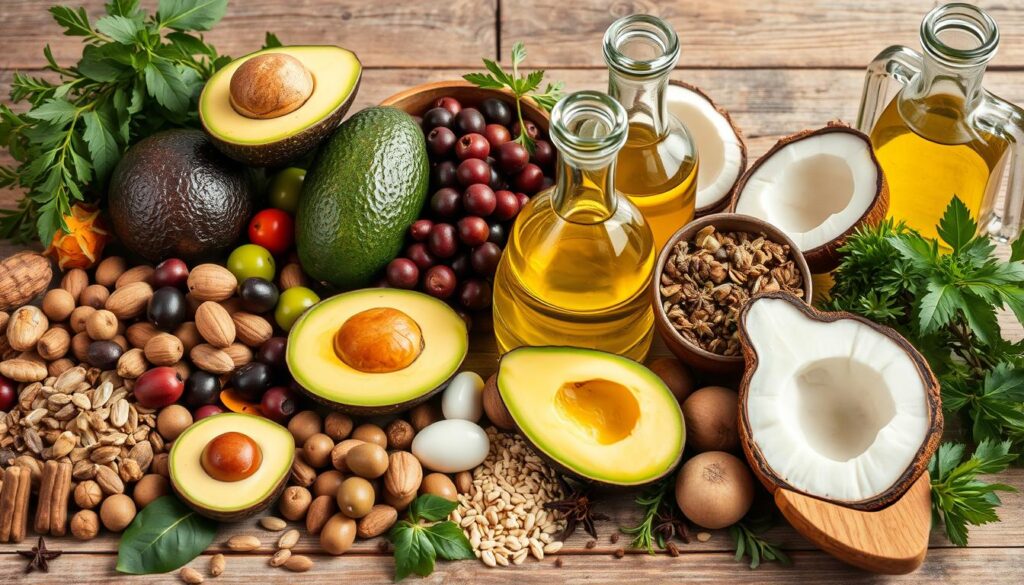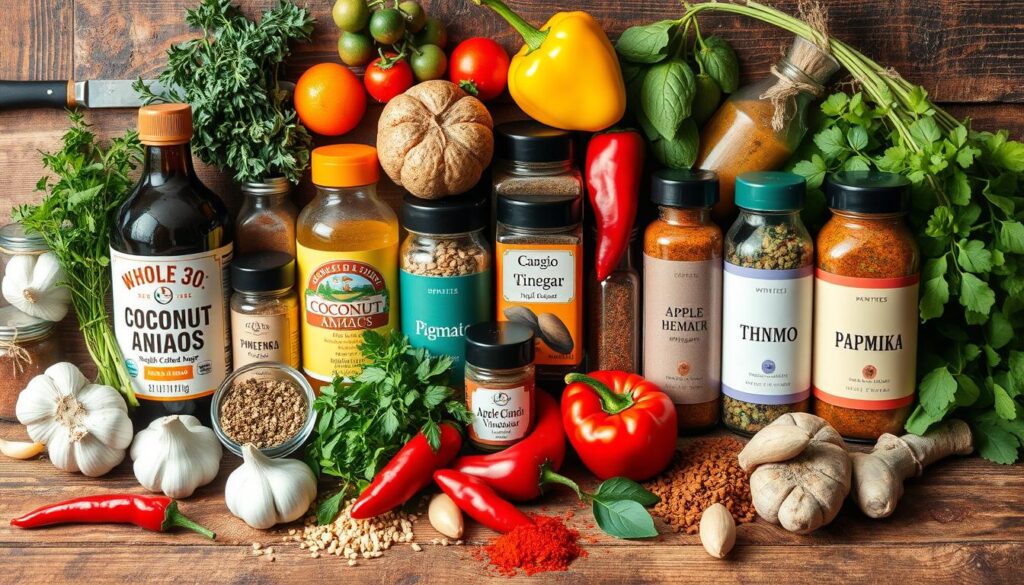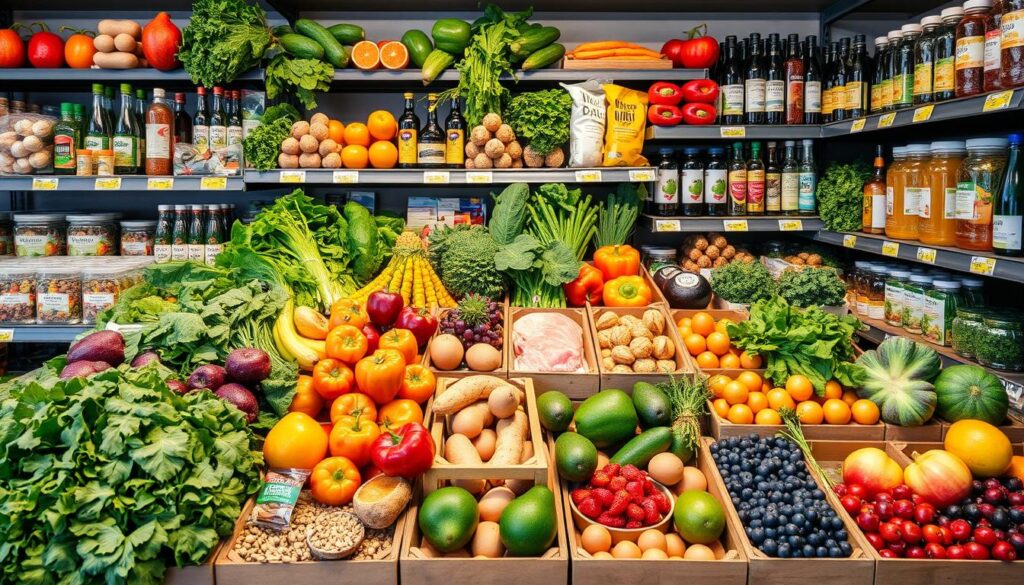The Whole30 diet is a 30-day plan to clean eat and feel better. It’s all about eating real foods and avoiding some groups. You can’t have added sugars, salt, artificial sweeteners, grains, dairy, or legumes.
It’s not just about losing weight. It’s about how you feel. The goal is to find out which foods make you feel bad. And to make a better food relationship.
Key Takeaways
- The Whole30 diet is a 30-day clean eating program that eliminates processed foods, added sugars, and certain food groups.
- Participants are encouraged to focus on how they feel during the program, rather than weight loss.
- The diet aims to help identify food sensitivities and establish a healthier relationship with food.
- Meal planning and preparation are crucial for successfully sticking to the Whole30 diet.
- Removing non-compliant foods from sight and having an accountability partner can improve adherence to the program.
Understanding the Whole30 Diet Fundamentals
The Whole30 diet is a 30-day plan to reset your diet. It focuses on eating whole, unprocessed foods. It doesn’t count calories or use points systems.
Instead, it removes foods that might cause problems or addictions. This helps improve your health and well-being.
What Makes Whole30 Different from Other Diets
The Whole30 diet is unique because of its strict rules. It’s not just about losing weight. It’s about making healthy eating a long-term habit.
The program teaches you to focus on feeling good, not just looking good. It tells you not to weigh yourself or take body measurements during the 30 days.
The Core Rules of Whole30
- Eliminate alcohol, grains, dairy, legumes, added sugars, and processed foods.
- Emphasize the consumption of fresh fruits, vegetables, high-quality meats, seafood, eggs, nuts, and seeds.
- Avoid recreating unhealthy foods with compliant ingredients, such as Whole30-approved desserts or baked goods.
- Carefully read labels to avoid hidden sugars and other forbidden ingredients.
Foods to Eliminate During Whole30
The Whole30 program asks you to avoid many foods. This includes:
- Sugar, natural or artificial sweeteners
- Alcohol
- Grains (wheat, rice, oats, corn, etc.)
- Legumes (beans, peas, lentils, peanuts, soy, etc.)
- Dairy products
- Processed foods and additives
By following these rules for 30 days, you can reset your food relationship. You’ll find out which foods might be causing problems. And you’ll see the benefits of the Whole30 diet.
Essential Proteins for Your Whole30 Diet Grocery List
High-quality proteins are key for the Whole30 diet. You should choose whole30 approved proteins like grass-fed beef and wild-caught seafood. These choices greatly impact your health.
Grass-fed beef is a top choice. It’s full of good nutrients and doesn’t have bad stuff. Pasture-raised chicken and pork are also great. They add flavor and lean protein to your meals.
Seafood lovers will enjoy wild-caught fish like salmon and tuna. Shellfish like shrimp and crab are also good. They add variety to your diet.
Always check the labels for “grass-fed” or “pasture-raised.” Stay away from processed meats with garlic, onion, or sugar. These are not whole30 compliant meats.
Choosing these whole30 approved proteins will help you succeed on your health journey. Your grocery cart will be filled with the best options.
Fresh Produce: Vegetables and Fruits Guide
Whole30 loves fresh, whole foods. This includes lots of whole30 approved vegetables and whole30 compliant fruits. You’ll find everything from leafy greens to sweet berries. These foods are key for a great Whole30 journey.
Approved Vegetables for Whole30
- Leafy greens (spinach, kale, lettuce)
- Cruciferous vegetables (broccoli, cauliflower, Brussels sprouts)
- Root vegetables (sweet potatoes, carrots, beets)
- Bell peppers
- Tomatoes
- Zucchini
- Asparagus
Whole30 Compliant Fruits
- Berries (blueberries, raspberries, strawberries)
- Citrus fruits (oranges, lemons, limes)
- Apples
- Bananas
- Pineapple
- Melons
- Avocados
Seasonal Shopping Tips
When you make your Whole30 grocery list, choose whole30 seasonal produce. This makes your food taste better and is healthier. Visit local farmers’ markets or your favorite grocery store. This helps local farmers and makes your Whole30 better.
Healthy Fats and Cooking Oils
Starting a Whole30 diet means adding whole30 approved fats and whole30 cooking oils to your meals. These fats help keep you full and give you energy. They are key for feeling good on the Whole30 program.
You can use many whole30 approved fats like avocado and coconut oil. You can also use duck fat and ghee. These fats are great for cooking and adding flavor to your food.
| Whole30 Approved Fats | Whole30 Cooking Oils |
|---|---|
|
|
On Whole30, pick your fats carefully. Choose from the list to get the right nutrients and energy. This helps your body do well on the diet.

Nuts, Seeds, and Their Derivatives
The Whole30 diet lets you eat many whole30 approved nuts and whole30 compliant seeds. These foods are full of nutrients. You can snack on them or add them to recipes.
Best Nuts for Whole30
- Almonds
- Brazil nuts
- Cashews
- Hazelnuts/Filberts
- Macadamia nuts
- Pecans
- Pine nuts
- Pistachios
- Pumpkin seeds/Pepitas
- Sesame seeds
- Sunflower seeds
- Walnuts
Compliant Nut Butters
For whole30 nut butters, the Whole30 diet has many choices. They must not have added sugars or bad additives. Good nut butter options are:
- Almond butter
- Cashew butter
- Macadamia butter
- Pecan butter
- Sesame seed butter (tahini)
- Sunflower seed butter
Peanuts and peanut butter are not okay on the Whole30 diet. They are legumes.
“Nuts and seeds are commonly used as ingredients in Plant-Based Whole30 recipes, providing healthy fats, protein, and a satisfying crunch.”
Whole30 Approved Seasonings and Condiments
Having the right seasonings and condiments is key for tasty Whole30 meals. Luckily, there are many whole30 compliant seasonings and whole30 approved condiments to choose from.
Must-have whole30 spices include basil, black pepper, and cayenne. Also, chili powder, cinnamon, and cumin are great. Garlic powder, ginger, oregano, paprika, and turmeric add flavor too.
For condiments, you can use apple cider vinegar and balsamic vinegar. Coconut aminos, mustard without sugar, and salsa are good choices. Also, hot sauce and compliant mayonnaise are okay. But, avoid condiments with garlic or onion because they’re high in FODMAPs.
By getting these whole30 compliant seasonings and whole30 approved condiments, you’ll make tasty Whole30 meals. These meals will keep you happy and full during the program.

“Seasonings and condiments can make or break a Whole30 dish. Having the right arsenal of whole30 spices and whole30 approved condiments is key to keeping your meals exciting and craveable.”
Beverages and Drinks on Whole30
Exploring drinks on Whole30 is fun. Water is key, but you’ll find many whole30 approved drinks and whole30 compliant beverages. They keep you hydrated and happy.
Approved Drinks List
Here are some whole30 drink options to keep you hydrated:
- Water (plain, sparkling, or flavored without additives)
- Unsweetened coconut water
- Herbal tea (no added sugars or artificial flavors)
- Black coffee (no sweeteners or creamers)
- Kombucha (check labels for added sugars)
- Fruit juices (in moderation)
These drinks are refreshing and follow Whole30 rules.
What to Avoid in Beverages
When looking for whole30 approved drinks, avoid these:
- Alcohol
- Dairy-based drinks (milk, yogurt drinks, etc.)
- Sodas and other sugary beverages
- Drinks containing artificial sweeteners or additives
Choosing the right drinks is key on Whole30. You’ll find many whole30 approved drinks. They help you stay healthy and happy.
Pantry Staples and Essential Items
Starting your Whole30 journey? It’s key to have the right whole30 pantry essentials, whole30 staple foods, and whole30 kitchen basics. These items help make cooking easy and keep you on track with Whole30.
Here are some whole30 pantry staples you need:
- Almond flour
- Arrowroot powder
- Beef, chicken, and fish broth
- Canned fish (salmon, tuna, sardines)
- Canned vegetables (olives, pumpkin, sweet potato)
- Coconut flour
- Dried fruits (unsweetened)
- Fish sauce
- Hot sauce
- Kimchi
- Mustard
- Pickles
- Sauerkraut
- Tapioca starch
Our research shows that extra-virgin olive oil is used in 38% of Whole30 recipes. Ground cumin is also very popular. Coconut aminos, ghee, and full-fat coconut milk are often used too.
| Whole30 Pantry Staple | Recommended Usage |
|---|---|
| Almond Flour | As a gluten-free flour alternative in baking and breading |
| Coconut Aminos | As a soy sauce substitute in various recipes |
| Ghee | For high-heat cooking and sautéing |
| Primal Kitchen Mayo | For homemade sauces, dressings, and dips |
| Full-Fat Coconut Milk | As a creamy dairy replacement in recipes |
Having these whole30 kitchen basics makes your Whole30 journey easier and more fun. Happy shopping!
Budget-Friendly Shopping Strategies
Starting the Whole30 diet doesn’t have to cost a lot. You can save money by choosing seasonal produce and buying in bulk. Also, frozen veggies and fruits are cheaper.
Money-Saving Tips
Watch for sales on meats and buy a lot when it’s cheap. Eggs and canned fish are cheaper proteins. Plan your meals to avoid waste and save money.
Use leftovers for quick meals or snacks. This way, you get more from your Whole30 groceries.
Bulk Buying Guide
- Buy non-perishable items and things you use a lot to avoid waste. This includes nuts, seeds, spices, and canned goods.
- Check the unit price to find the best deal, even if it costs more. Buying in bulk saves money over time.
- Trader Joe’s is great for cheap Whole30 shopping. Their store brands are often cheaper than others.
- Choose affordable ingredients like spaghetti squash, vegan kale pesto, and avocado guacamole. They’re versatile and easy to use.
Follow these whole30 on a budget tips for affordable whole30 shopping. You can make tasty and healthy whole30 meal prep without spending a lot.
Meal Prep and Storage Solutions
Keeping up with a whole30 meal prep plan is key for the whole30 diet. Spending time on prep work makes meals easier and keeps you on track. It helps you have whole30 meal planning options ready to go.
Start with proteins, veggies, and safe sauces or dressings. Cook big batches and store them in airtight glass containers. This makes it easy to grab a meal without cooking every day.
- Chop and store veggies in sealed containers to save time.
- Make small batches of dressings and sauces to keep them fresh.
- Freeze cooked meats and veggies for later.
- Label everything with the date to keep track of freshness and avoid waste.
Choosing the right whole30 food storage tools is important. Use glass containers to see what’s inside and keep food fresh. This helps you stay creative in the kitchen and avoids forgotten food.
| Essential Whole30 Meal Prep Tools | Benefits |
|---|---|
| Glass Storage Containers | Maintain freshness, allow visibility of contents |
| Food Processor | Quickly chop, slice, and purée ingredients |
| Immersion Blender | Blend sauces, dressings, and dips with ease |
| Baking Sheets | Roast vegetables and proteins in bulk |
Focus on whole30 meal prep and use the best storage tools. This way, you’ll do great on your whole30 diet journey. Enjoy the ease of having meals ready and the freedom to eat well anytime.
Conclusion
The Whole30 diet helps you reset your food relationship and boost your health. It guides you through a 30-day program. You’ll learn to shop for whole foods and read labels.
Start by focusing on foods without added stuff. Plan your meals ahead. This makes the diet easier to follow.
Once the diet is over, slowly add back foods you missed. This helps you find out what works best for you. You might feel more energetic and sleep better.
Choosing the Whole30 diet can change your life. It helps you control your health. With the right mindset and planning, you can keep up with the diet.


A Life-Changing Experience with This Weight Loss Supplement (Nagano Tonic)
I’ve always struggled with finding a weight loss solution that actually works for me. Like many, I’ve tried numerous diets, exercise routines, and supplements over the years—some worked for a short time, but nothing ever gave me long-term results. That was until I decided to try the weight loss supplement I found : Link to the Supplement.
From the moment I started using it, I noticed a difference. Not only did I feel more energized, but my cravings also became more manageable. The best part? I started seeing results much quicker than I anticipated! Over the course of just a few weeks, I noticed a significant reduction in belly fat and overall weight loss that I hadn’t been able to achieve before.
What makes this supplement stand out from all the others I’ve tried is how it supports me in my daily routine without any jitters or energy crashes. I’m able to stay focused and motivated, which has made it easier to stay on track with my diet and exercise plan.
This product truly exceeded my expectations, and I feel more confident and healthier than ever before. If you’re struggling with your weight loss journey like I was, I highly recommend giving this supplement a try. It’s been a game-changer for me, and I’m sure it can work wonders for you too!
Contant Them on email .. tonicnagano50@gmail.com
I’ve tried so many weight loss products over the years, but nothing worked like this supplement! Since I started using it, I’ve noticed a big difference in my energy levels and appetite control. In just a few weeks, I’ve lost weight and feel so much better. It’s been easy to stick with, and the results speak for themselves. Highly recommend this to anyone looking to make a real change!
wasn’t sure what to expect, but this weight loss supplement has really impressed me! After just a few weeks of use, I’ve already dropped a few pounds and feel more motivated to stay active. It’s helped curb my cravings and boosted my energy throughout the day. I’m excited to keep going and see even better results. Definitely worth trying!
Reach them on tonicnagano50@gmail.com
I was skeptical at first, but this supplement has truly made a difference in my weight loss journey. I’ve lost weight without feeling deprived or sluggish. My cravings are under control, and I feel more confident in my body. It’s easy to incorporate into my daily routine, and the results speak for themselves. I’m so glad I gave it a try!
Thanks David, i do use the link to make my purchase. you can get too here http://surl.li/iasppy
I’ve tried so many weight loss products, but this one has been by far the most effective. In just a few weeks, I’ve noticed a visible difference in my body and energy levels. It’s helped me stay on track without the constant hunger pangs and cravings. I’m really happy with my progress and can’t wait to see where I’ll be in another month!
This Nagano Tonic has been amazing! In just a few weeks, I’ve lost weight, feel more energized, and my cravings are under control. Highly recommend it!
Thats the link to purchase http://surl.li/iasppy